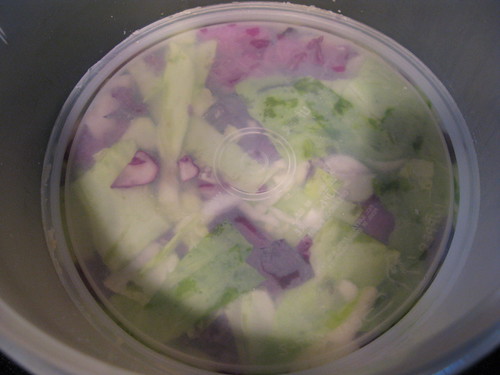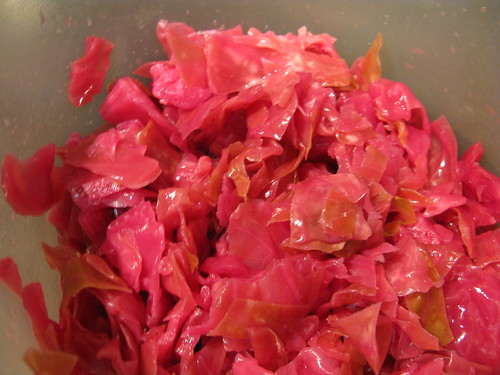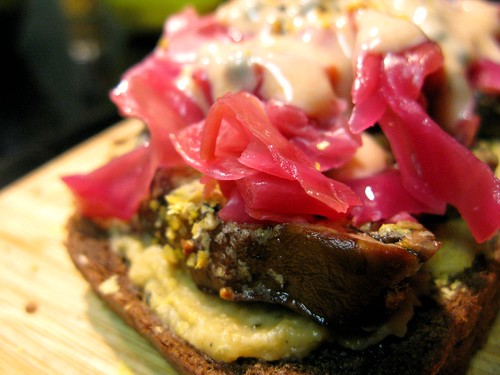During my visit to Chicago in early October, I spent a lot of time in small bookstores and infoshops, browsing for some new reading materal. Quimby's was an awesome little shop full of unqiue books, comics, zines, and general schwag. I decided to pick up a copy of Sandor Katz's Wild Fermentation, and was not disappointed. I've read that zine cover-to-cover several times, and I'm really looking forward to working through the many recipes included. Since the only thing I've ever fermented was sourdough, I thought I'd start slow with the first and most notable fermented food: Sauerkraut!

Since this was my first attempt, I made a really small batch. As per Sandorkraut's recommendation, I mixed 2 parts green cabbage with 1 part red cabbage for a purdy pink kraut. You can slice or shred the cabbage however you like, just remember that larger pieces will take longer to break down. I went with larger slices and a few thin shreds. As you chop your veggies, add them to a large food grade bucket and sprinkle with NON-iodized salt (very important to use the stuff that isn't iodized, as it will inhibit the growth of good bacteria), repeating this process each time you add a new layer.
Pack the cabbage as you add more layers; I used a potato masher but clean fists will also do the trick. Continue to add-and-pack until you used up all the cabbage. Note that the resulting kraut will shrink to more than half the size of the fresh cabbage.

Once you've added all the cabbage, liberally salted, you'll want to top your veggies with a clean plate that fits perfectly snug into your container (I used the lid of another plastic container, which fit perfectly). Top that plate with a jug filled with water, or any other heavy item you have on hand. For the next day or so, as often as you remember, push the jug into the kraut as hard as you can. This will help the salt draw moisture from the cabbage, creating the brine in which the cabbage will ferment! After the first day, cover your fermenting cabbage with a cloth to keep away flys and dust. Every couple of days, I pressed mine back down to make sure the cabbage was covered with brine. After almost two weeks, it was ready!

It'll keep fermenting for another month or so (longer in cold weather), but once it gets super soft, it might not taste so good. I moved mine into the fridge and am so pleased with my first fermentation project. It was really easy!! As you saw before, I tried my first batch on a portobello Reuben sandwich.





oooooh! at-home fermentation is so impressive! i'd love some homemade kraut with a tofurkey beer brat, myself!
ReplyDeleteGood for you for trying something new! That book is awesome. Have you tried any of the spice variations? I think caraway kraut is my next kraut adventure!
ReplyDelete